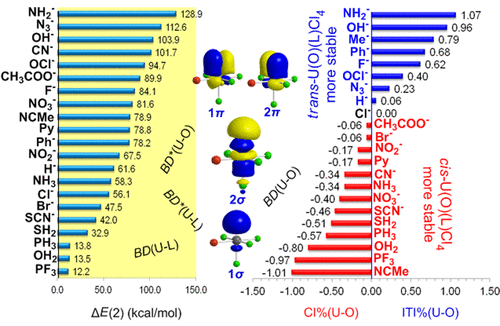当前位置:
X-MOL 学术
›
Inorg. Chem.
›
论文详情
Our official English website, www.x-mol.net, welcomes your
feedback! (Note: you will need to create a separate account there.)
cis- and trans-Ligand Effects on the Inverse trans-Influence in [UVI(O)(L)Cl4]0/- (L = Unidentate Ligand) Complexes.
Inorganic Chemistry ( IF 4.3 ) Pub Date : 2020-06-17 , DOI: 10.1021/acs.inorgchem.0c00778 Athanassios C Tsipis 1
Inorganic Chemistry ( IF 4.3 ) Pub Date : 2020-06-17 , DOI: 10.1021/acs.inorgchem.0c00778 Athanassios C Tsipis 1
Affiliation

|
A comprehensive exploration of the inverse trans-influence (ITI) phenomenon in a series of cis-[UVI(O)(L)Cl4]0/– and trans-[UVI(O)(L)Cl4]0/– complexes involving a wide variety of neutral and anionic unidentate ligands L, using relativistic density functional theory, threw light on the still-intriguing physics of ITI, elucidated its origin, and deployed the ligands L in cis- and trans-ITI sequences (ladders). ITI is produced for the complete set of L in both series of [U(O)(L)Cl4]0/– complexes, but this is not reflected in the thermodynamic stability of the [U(O)(L)Cl4]0/– isomers. In effect the hard and strong σ-donor anionic ligands stabilize the trans isomers, but the opposite is true for the soft σ-donor/π-donor neutral and anionic ligands that stabilize the cis isomers. According to the ITI%(U–L) metrics the hard strong σ-donor anionic ligands exert stronger ITI than the soft σ-donor/π-donor neutral ones, while according to the ITI%(U–O) metrics ITI is produced only for the more stable trans-[U(O)(L)Cl4]0/– isomers involving the anionic ligands. In contrast the neutral ligands in the more stable cis-[U(O)(L)Cl4]0/– isomers produce the normal cis influence (CI). Furthermore, the more electronegative ligands produce stronger ITI. ITI%(U–O) cis- and trans-philicity ladders are also built for both series of complexes employing the isotropic σiso(SO) 17O NMR shielding constants as a sensitive metric of the ITI phenomenon. The NMR ITI%(U–O) metrics are consistent with the ITI%(U–O) ones illustrating that the isotropic 17O NMR shifts are sensitive metrics of the covalency of the multiple U–O bonding mode and, hence, of the ITI phenomenon. Interestingly the 2σ BD(U–O) natural bond orbitals play a key role in tuning the bond length and covalency of the U–O bond through the 2σ(U≡O) → 2σ*(U≡O) hyperconjugative interactions. The assessment of the magnitude of the ITI in the [UVI(O)(L)Cl4]0/– complexes and the recognition of the factors affecting ITI dispose a guide to experimentalists working in the area of uranium chemistry to develop strategies for stabilizing uranium-ligand linkages.
中文翻译:

顺式和反式配体对[UVI(O)(L)Cl4] 0 /-(L =未知配体)配合物的反式反式影响。
的逆的综合勘探反-influence(ITI)现象在一系列的顺式- [C VI(O)(L)氯4 ] 0 / -和反式- [C VI(O)(L)氯4 ] 0 /-使用相对论密度泛函理论,涉及多种中性和阴离子不明配体L的复合物,阐明了ITI仍然令人着迷的物理原理,阐明了其起源,并将配体L应用于顺式和反式-ITI序列(梯子)。在两个[U(O)(L)Cl 4 ]系列中L的完整集合都生成了ITI 0 / –[U(O)(L)Cl 4 ] 0 / –异构体的热力学稳定性未反映出这一点。实际上,硬而强的σ供体阴离子配体稳定了反式异构体,但相反的是,软σ供体/π供体中性和阴离子配体稳定了顺式异构体。根据ITI%(U–L)指标,硬的强σ-供体阴离子配体比软的σ-供体/π-供体中性配体发挥更强的ITI,而根据ITI%(U–O)指标产生ITI仅对于涉及阴离子配体的更稳定的反式-[U(O)(L)Cl 4 ] 0 /-异构体。相反,更稳定的顺式中性配体-[U(O)(L)Cl 4 ] 0 /-异构体产生正常的顺式影响(CI)。此外,带负电的配体产生更强的ITI。ITI%(U-O)的顺式-和反式-philicity梯子也内置两个系列采用各向同性σ络合物的异(SO)17 öNMR屏蔽常数为敏感量度的ITI现象。NMR ITI%(U–O)度量与ITI%(U–O)度量一致,说明各向同性17O NMR位移是多个U–O键合模式共价的敏感指标,因此也是ITI现象的敏感指标。有趣的是,2σBD(U–O)自然键轨道在通过2σ(U≡O)→2σ*(U≡O)超共轭相互作用调节U–O键的键长和共价中起关键作用。对[U VI(O)(L)Cl 4 ] 0 / –络合物中ITI强度的评估以及对影响ITI的因素的认识,为从事铀化学领域实验工作的实验人员提供了指南稳定铀-配体键。
更新日期:2020-07-06
中文翻译:

顺式和反式配体对[UVI(O)(L)Cl4] 0 /-(L =未知配体)配合物的反式反式影响。
的逆的综合勘探反-influence(ITI)现象在一系列的顺式- [C VI(O)(L)氯4 ] 0 / -和反式- [C VI(O)(L)氯4 ] 0 /-使用相对论密度泛函理论,涉及多种中性和阴离子不明配体L的复合物,阐明了ITI仍然令人着迷的物理原理,阐明了其起源,并将配体L应用于顺式和反式-ITI序列(梯子)。在两个[U(O)(L)Cl 4 ]系列中L的完整集合都生成了ITI 0 / –[U(O)(L)Cl 4 ] 0 / –异构体的热力学稳定性未反映出这一点。实际上,硬而强的σ供体阴离子配体稳定了反式异构体,但相反的是,软σ供体/π供体中性和阴离子配体稳定了顺式异构体。根据ITI%(U–L)指标,硬的强σ-供体阴离子配体比软的σ-供体/π-供体中性配体发挥更强的ITI,而根据ITI%(U–O)指标产生ITI仅对于涉及阴离子配体的更稳定的反式-[U(O)(L)Cl 4 ] 0 /-异构体。相反,更稳定的顺式中性配体-[U(O)(L)Cl 4 ] 0 /-异构体产生正常的顺式影响(CI)。此外,带负电的配体产生更强的ITI。ITI%(U-O)的顺式-和反式-philicity梯子也内置两个系列采用各向同性σ络合物的异(SO)17 öNMR屏蔽常数为敏感量度的ITI现象。NMR ITI%(U–O)度量与ITI%(U–O)度量一致,说明各向同性17O NMR位移是多个U–O键合模式共价的敏感指标,因此也是ITI现象的敏感指标。有趣的是,2σBD(U–O)自然键轨道在通过2σ(U≡O)→2σ*(U≡O)超共轭相互作用调节U–O键的键长和共价中起关键作用。对[U VI(O)(L)Cl 4 ] 0 / –络合物中ITI强度的评估以及对影响ITI的因素的认识,为从事铀化学领域实验工作的实验人员提供了指南稳定铀-配体键。











































 京公网安备 11010802027423号
京公网安备 11010802027423号